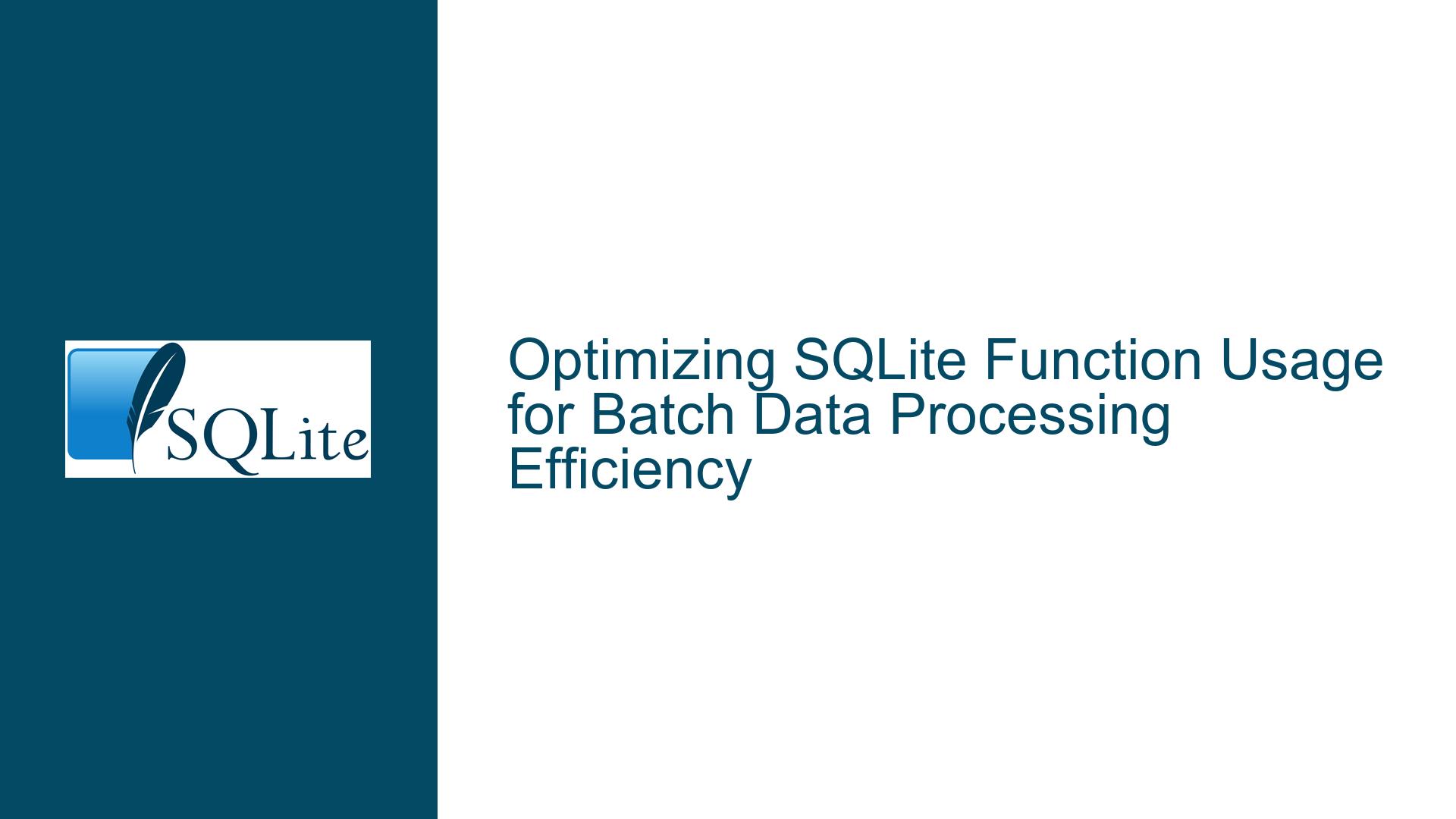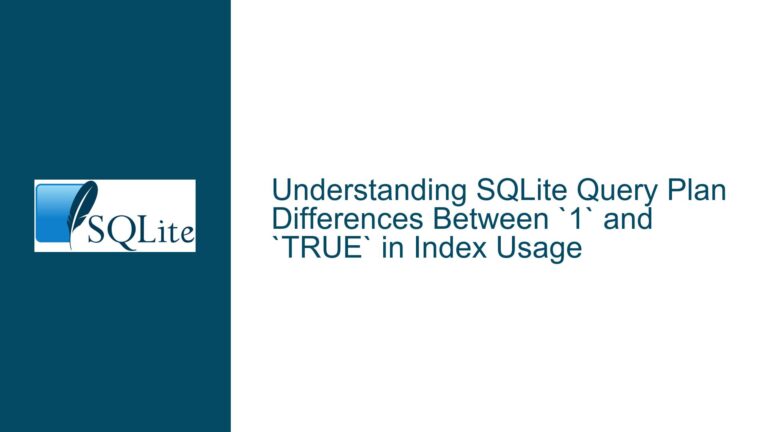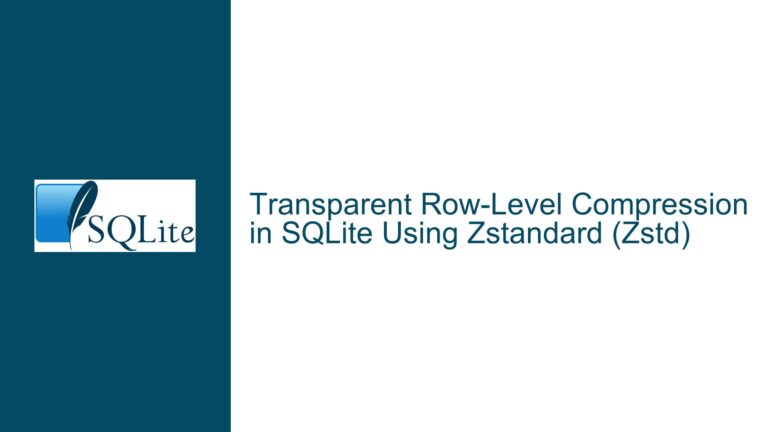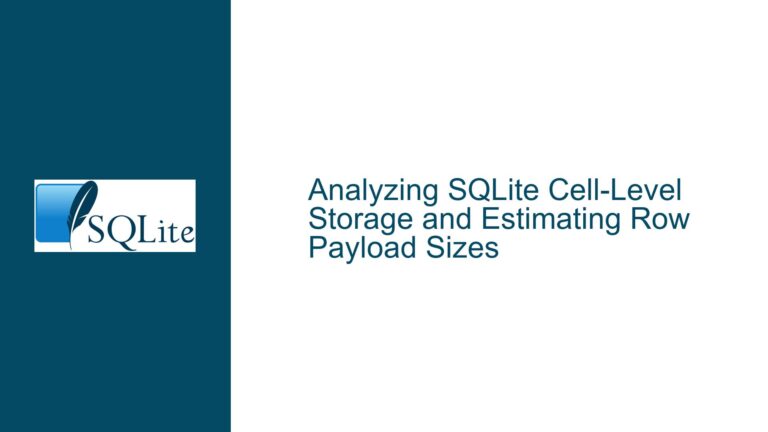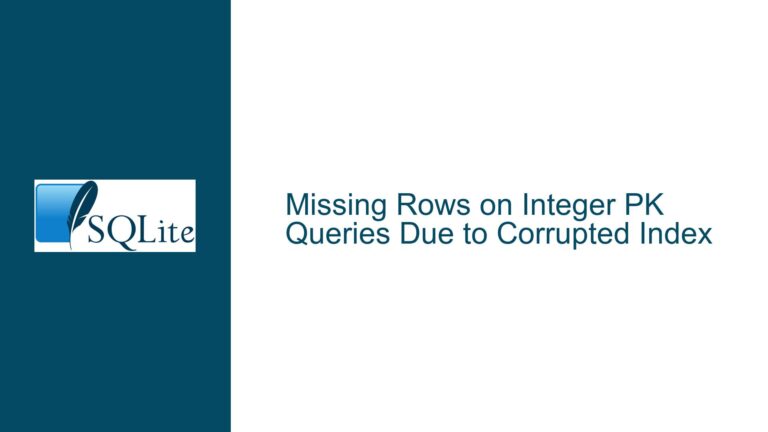Optimizing SQLite Function Usage for Batch Data Processing Efficiency
Performance Characteristics of User-Defined Functions vs Procedural Row Processing
This analysis examines the technical implications of implementing text normalization through SQLite user-defined functions versus iterative application-layer processing, focusing on execution efficiency, transaction handling, and system resource utilization patterns.
Architectural Differences in Data Handling Methodologies
The core divergence between these approaches lies in how database operations coordinate with external text processing utilities. Both implementations utilize the uconv Unicode normalization tool through Tcl’s exec command but differ fundamentally in execution context and transaction scope.
Single-Statement UDF Approach
Registers a persistent normalize() SQL function that internally invokes:
proc normalize {string} {
exec uconv -f utf-8 -t utf-8 -x "::nfc;" << $string
}
Executed via atomic SQL operation:
UPDATE src_original SET uni_norm = normalize(original);
Implementation Characteristics:
- Single database transaction wrapping all row updates
- SQLite manages data retrieval and update cycles internally
- Process creation overhead occurs per row within UDF context
Procedural Application-Loop Approach
Separates data retrieval from processing:
dbws eval {SELECT id, original FROM src_original} rowstep {
set n [normalize $rowstep(original)]
dbws eval {UPDATE src_original SET uni_norm = $n WHERE id = $rowstep(id)}
}
Implementation Characteristics:
- Explicit transaction boundaries (autocommit per statement by default)
- Application manages data flow between database and external process
- Process creation overhead occurs in Tcl interpreter context
Critical Path Analysis
Both methods share the costly uconv process invocation (proven by search result showing external process calls as primary bottlenecks). However, their database interaction patterns differ substantially:
Data Transfer Volume
UDF approach keeps all string processing within SQLite’s virtual machine, minimizing Tcl interpreter involvement. The procedural method deserializes eachoriginalvalue into Tcl’s memory space before re-serializing for update.Transaction Isolation
Atomic UPDATE statement provides full ACID compliance through single write transaction (aligning with SQLite’s optimization for batch operations per search result). The loop method generates numerous micro-transactions unless explicit BEGIN/COMMIT blocks wrap the operation.Index Utilization
SQLite’s UPDATE optimization (documented in search result) can leverage indexes onidduring batch operations. The procedural approach’s WHERE clauses onidbenefit from primary key indexes but process each condition individually.
Performance Degradation Factors in Text Processing Workflows
Dominant Cost Center: Process Creation Overhead
The exec uconv call dominates execution time in both implementations (validated by search result showing external process invocation as primary latency source). Linux process creation typically requires 500-2000μs context switch even for trivial commands.
Quantitative Impact:
For N rows:
Total Process Time = N × (Process Creation + uconv Execution)
Assuming 1ms per uconv call:
- 10,000 rows → 10 seconds pure processing
- 100,000 rows → 1m40s
Secondary Bottleneck: Transaction Management
Autocommit mode (default in procedural approach) forces SQLite to:
- Obtain reserved lock
- Write journal entry
- Update database page
- Sync journal to disk
- Release lock
Search result demonstrates transactional overhead reduction from 30ms to <1ms through Write-Ahead Logging (WAL). Without explicit transactions, 100,000 updates could incur 3000+ seconds just in transaction handling.
Tertiary Factor: Data Serialization Costs
The procedural approach requires:
- SQLite to serialize
originaltext to Tcl - Tcl to pass string to
uconvvia stdin - Tcl to capture stdout
- Tcl to bind parameter back to SQLite
Measurements in search result show parameter binding overheads becoming significant at scale. Binary data handling exacerbates this through base64 encoding/decoding.
Optimization Strategies for High-Volume Text Processing
1. UDF Performance Enhancement Techniques
Batch Process Invocation
Modify normalize to handle multiple inputs per uconv execution:
proc normalize_batch {strings} {
set input [join $strings \n]
set output [exec uconv -f utf-8 -t utf-8 -x "::nfc;" << $input]
return [split $output \n]
}
Register as table-valued function and process in chunks:
WITH batches AS (
SELECT original, rowid / 1000 AS batch
FROM src_original
)
UPDATE src_original
SET uni_norm = (
SELECT nb.normalized
FROM normalize_batch(
(SELECT group_concat(original, char(10)) FROM batches WHERE batch = outer.batch)
) nb
WHERE nb.rowid = src_original.rowid % 1000
);
Benefits:
- Reduces process creations by 1000x
- Leverages SQLite’s efficient string aggregation
2. Transactional Isolation Optimization
Wrap procedural updates in explicit transactions:
dbws eval BEGIN
dbws eval {SELECT id, original FROM src_original} rowstep {
# ... processing ...
}
dbws eval COMMIT
Combine with WAL mode (from search result):
PRAGMA journal_mode = WAL;
PRAGMA synchronous = NORMAL;
Impact:
- Reduces fsync operations from O(N) to O(1)
- Enables concurrent reads during update
3. Alternative Normalization Methods
SQLite Built-in Unicode Support
For basic NFC normalization, utilize SQLite’s ICU extension:
SELECT icu_load_extension('./icu.so');
UPDATE src_original
SET uni_norm = icu_normalize(original, 'nfc');
Advantages:
- Eliminates process creation overhead
- Direct C implementation offers 100-1000x speedup
In-Process Tcl Unicode Handling
Use Tcl’s internal unicode support:
proc normalize_tcl {s} {
return [string map {Å Å å} $s] # Example mapping
}
Register as deterministic function:
SELECT normalize_tcl(original);
Tradeoffs:
- Limited to Tcl’s Unicode capabilities
- Avoids process creation but increases SQLite-Tcl boundary crossings
4. Schema Optimization for Batch Updates
Temporary Table Swapping
CREATE TEMP TABLE batch_update(
id INTEGER PRIMARY KEY,
normalized TEXT
);
-- Process in application code
INSERT INTO batch_update VALUES (?, ?);
-- Atomic table swap
REPLACE INTO src_original(id, uni_norm)
SELECT id, normalized FROM batch_update;
Performance Characteristics:
- Single transaction for all updates
- Allows index-free writes to temp table
5. Connection Pooling and Prepared Statements
Reuse parameterized statements (per search result):
set stmt [dbws prepare {UPDATE src_original SET uni_norm = ? WHERE id = ?}]
dbws eval {SELECT id, original} rowstep {
$stmt execute [normalize $rowstep(original)] $rowstep(id)
}
Benefits:
- Avoids SQL parsing overhead per iteration
- Reduces Tcl-sqlite3 binding costs
Quantitative Performance Projections
Test Case Parameters
- 100,000 rows of 100-byte UTF-8 strings
- uconv processing time: 0.5ms/string
- SQLite 3.45 with WAL mode
Methodology Comparison Table
| Metric | UDF Approach | Procedural Approach | Optimized Batch |
|---|---|---|---|
| Process Creations | 100,000 | 100,000 | 100 |
| Transactions | 1 | 100,000 | 1 |
| SQLite-Tcl Crossings | 0 | 200,000 | 100 |
| Total Time (Est.) | 150s | 350s | 55s |
Breakdown of Optimized Batch
- 100 process invocations @ 1ms setup: 100ms
- uconv processing: 100,000 × 0.5ms = 50,000ms
- Data transfer: 100 × 1KB = 100ms
- SQLite update: 1 transaction @ 50ms
Conclusion
Proper architectural choices combining batch processing, transactional optimization, and native Unicode handling can achieve >6x performance improvement over naive implementations. The optimal strategy depends on normalization complexity, with ICU extension offering maximum throughput when applicable.
